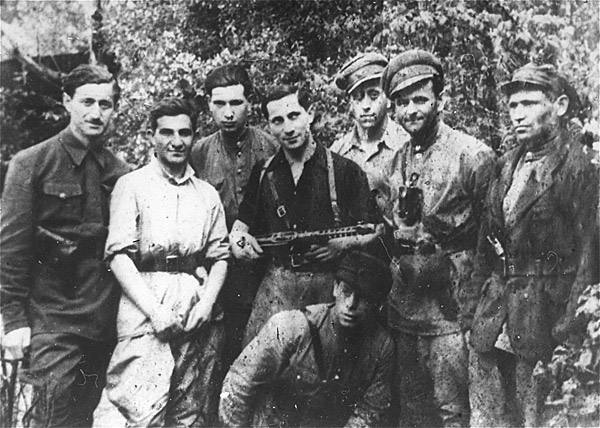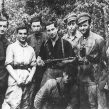
The Partisan Movements in Belarus During World War II (Part Two)
Publication: Eurasia Daily Monitor Volume: 12 Issue: 24
By:

Perhaps in no other modern-day country, with the exception of Israel, have Jews historically made up a larger percentage of the overall population as in Belarus. For example, in 1897, Jews comprised 14.2 percent of the residents of Belarusian territory; and in Grodno and Minsk regions, Jewish populations made up between 16 and 17 percent (Demoscope, March 2003). Three presidents of Israel, Chaim Weizmann, Zalman Shazar and Shimon Peres; Prime Ministers Menachem Begin and Yitzhak Shamir; the pioneer of the revival of the Hebrew language, Eliezer Ben-Yehuda; as well as the artist Marc Chagall were all born in Belarus. According to the Soviet census of 1926, Jews accounted for more than 40 percent of the population of Minsk (BSE, V.39, accessed February 6). By 1941, Jews in Belarus numbered almost one million (Leonid Smilovitsky, Jews Under Soviet Rule, Vol. 49, 2008/2-3). From 1924 to 1930, Yiddish was an official language of Soviet Belarus along with Belarusian, Russian and Polish.
On June 22, 1941, Belarus became the first victim of the Nazi German invasion launched against the Soviet Union. Predictably, more Jews (up to 64 percent) managed to escape from the eastern part of Belarus than from the areas occupied by the end of June and situated further west (11 percent). Minsk surrendered to the Germans on June 28, 1941. During the war, more than 800,000 Belarusian Jews perished (Leonid Smilovitsky, The Holocaust in Belorussia, from 1941–1944, Tel Aviv: 2000, pp. 147–159).
Historian Leonid Smilovitsky has meticulously studied all of the 1941–1944 messages transmitted by the Soviet authorities to the underground partisan movement and to the population of the occupied territories (via radio, leaflets, and official publications). However, in his research, Smilovitsky could not find a single instance of Moscow officially appealing to or ordering the local populations or existing partisan movements to come to the aid of Jews, who were the first victims of the occupying Nazi German forces (Smilovitsky, The Holocaust in Belorussia, pp. 147–159).
Despite a lack of top-down orders to do so, the partisan movement of Belarus (see Part One in EDM, January 30) played a huge role in rescuing Jews. Many Jews from small settlements escaped to the woods and joined fighting partisan units. For example, in the seven units of the “Lenin” partisan brigade, which included 1,728 members, 266 were Jews. And out of the 821 partisans of the Soviet Belarus brigade, 176 were Jewish. In the units where Jews were a small minority, they usually did not identify as such and, in many cases, changed their names due to a certain of level of anti-Semitism present in these groups (Smilovitsky, The Holocaust in Belorussia, pp. 147–159).
The charge of any existence of anti-Semitism among Belarusians is a particularly sensitive subject. In addition to seeing itself as a “respublika-partizanka” (partisan republic), the other persistent facet of Belarus’s self-identity is of a nation that shows utmost tolerance to representatives of other ethnicities and faiths. Nonetheless, according to Belarusian analyst Anatoly Taras, “utmost tolerance” is an exaggeration just as “utmost xenophobia” would be; he describes his fellow countrymen as “moderately xenophobic” (Belarus Security Blog, January 30). This categorization reflects the results of modern-day national polls (for example, Independent Institute for Socio-Economic and Political Studies, December 2007) as well as a wealth of anecdotal evidence, including that contained in popular fiction books (see, for instance, Lyudmila Ulitskaya’s Daniel Stein: Interpreter [2011] or Adam and Miriam [2010] by Dina Rubina) and newspaper articles (Belgazeta, January 25, 2013). Indeed, 711 Belarusians were recognized after the war as Righteous Among Nations for rescuing Jews at a risk to their own lives; but there were also many documented instances of the mistreatment of Jews by the partisans (Smilovitsky, The Holocaust in Belorussia, pp. 147–159).
Perhaps, in part, this evidence explains the emergence of several exclusively Jewish partisan units in Belarus during the Second World War. Among 14 of those (in total, numbering 1,650 fighters), the most publicized one was the detachment led by Tuvya Bielsky along with his three brothers. This unit was active in Nalibokskaya Pushcha, a wooded area between the towns of Lida and Novogrudok, in Grodno Oblast. The activities of the Bielsky detachment are described in books by Nehama Tec (Defiance, 1993) and Peter Duffy (The Bielski Brothers: The True Story of Three Men Who Defied the Nazis, Built a Village in the Forest, and Saved 1,200 Jews, 2004), and were portrayed on the big screen in the 2008 feature film Defiance (based on Tec’s book), starring Daniel Craig as Tuvya Bielsky, as well as in the 2006 documentary The Bielsky Brothers: Jerusalem in the Woods.
The Bielskys’ roots were in the village of Stankevichy, where they were the only local Jewish family. Born in 1906, Tuvya Bielsky attended a Jewish religious school and then a regular Polish school (as western Belarus was found within the borders of interwar Poland until September 17, 1939). He served in the Polish army as a corporal. After western Belarus became part of the Belarusian Soviet Socialist Republic, Bielsky escaped Communist purges targeting small business owner by leaving his grocery store and obtaining a job as an accountant’s aide. When, in June 1941, his hometown was overrun by Nazi German forces, 4,000 local Jews were immediately exterminated, including Bielsky’s parents, two of his brothers and his newly-born daughter. Tuvya and 17 of his relatives escaped to the woods and created a Jewish partisan unit. By August 1942, the unit consisted of 250 fighters and by the spring of 1943, it had 750 members. At that point, the unit bore the name of “Ordzhenikidze” (after Soviet dignitary Grigory Ordzhenikidze) and joined the Soviet-led partisan brigade named after Kirov. The unit rescued 1,230 Jews, derailed 6 enemy trains, blew up 20 bridges, destroyed 16 vehicles, and killed more than 250 Wehrmacht soldiers and officers. Tuvya’s brother Zus personally killed 47 Germans and their collaborators.
Soon after the war, Tuvya and Zus escaped through a still porous border to Poland and from there traveled to Palestine. After the founding of Israel, they participated in its first war against Arab armies. Tuvya died in 1986, in Brooklyn, New York.
The first post-war Soviet Census of 1959 recorded just 150,100 Jews in Belarus. Thereafter, their numbers consistently declined due to intermarriage and, since 1973, mass emigration. The 1999 census recorded only 27,810 self-identified Jews in Belarus (Demoscope, March 2003) and the 2009 census—just over 13,000. Yet, surprisingly, some of them are more visible in positions of power today than during the post-war decades in Soviet Belarus, when Jews were still a relatively numerous minority.
The legacy of Belarusian Jews during World War II, not to mention their centuries-long history of co-existence with ethnic Belarusians will likely persist in both peoples’ memory for a long time to come. A growing number of tourists visit Belarus each year to pay homage to surviving Jewish cemeteries and other landmarks of Jewish life. And the government of Belarus openly welcomes those visitors.




